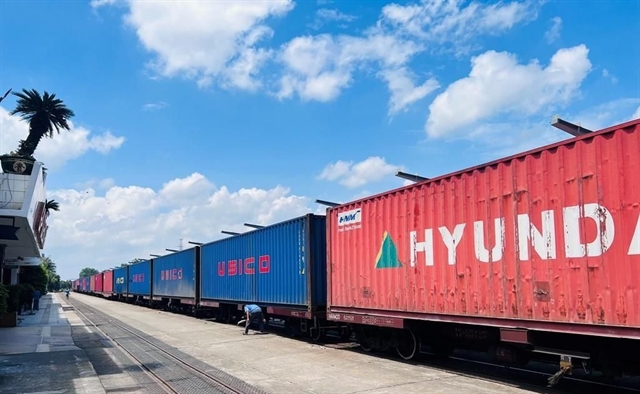 Economy
Economy


|
| In 2022, total volume of cargo exported via the international intermodal rail reached 1.33 million tonnes, including goods from Việt Nam to China and goods transiting China to third countries. — Photo bnews.vn |
HÀ NỘI — Việt Nam is boosting the export of agricultural products to China by rail, especially fresh fruits and seafood, according to the Railway Transport and Trading Joint Stock Company (Ratraco).
Last month, the first train for import-export agricultural products on the Sóng Thần - Đồng Đăng route departed from Sóng Thần railway station, Bình Dương Province.
The train had about 900 tonnes of goods in 21 refrigerated 40-foot containers of fresh fruit and seafood going to Yên Viên railway station before arriving at Đồng Đăng railway station, Lạng Sơn Province toward China.
Previously, at Kép railway station, the railway industry coordinated with Bắc Giang Province to operate trains transporting fresh lychees exported to China in refrigerated containers.
A representative of Ratraco said that to transport dried agricultural products for export, such as dried tea and tapioca starch, the railway industry has had many carriages for regular containers to meet the demand of customers.
However, at present, the needs of customers are to transport import/export fresh agricultural products. So, the railway industry is interested in the increasing demand for transporting fresh farming products because it brings better revenue.
The transport cost for a container of dry goods on the North-South route is only about VNĐ30-35 million for one round trip, but this price for a container of fresh fruit can be VNĐ35 million one way.
Meanwhile, the transport price for a container on the road at the North-South route is VNĐ60 million during off-peak periods and VNĐ100-120 million during peak periods.
Therefore, if the railway has carriages and solutions on the organisation of transport for fresh farming products, it will meet the needs.
The railway has rented standard refrigerated containers from China to ensure the quality of goods, and can transport deeply in China as well as third countries. A train can transport 20 containers to the border gate with China. Then, the goods can go to China by road or trail.
The representative said the enterprise had developed a separate transport process for the trains transporting refrigerated containers of import and export agricultural and food products from Sóng Thần to Đồng Đăng.
The trains transport fresh fruits from the South to China and take Chinese fruits such as fresh grapes and fresh garlic from Lào Cai to Sóng Thần railway station, said the representative.
A lot of Vietnamese agricultural products have shipped to China by sea. But for fresh fruit, sea shipping is not the top choice because shipping time is long, while Viet Nam's exported fresh fruit has a shelf life of about 25-27 days at most from the date of harvest until them on shelves for sales.
Rail transport is an effective time-saving solution. However, fresh agricultural and fruit products traveling by rail must be official export and meet strict requirements from having origin from the coded growing areas to packaging specifications.
The representative said the agricultural products transported at refrigerated container by train on the Sóng Thần - Đồng Đăng route are under official export with high quality. They are usually only sold at supermarkets, like a container of durian with a value of up to VNĐ4 billion.
In 2022, total volume of cargo exported via the international intermodal rail reached 1.33 million tonnes, accounting for 24 per cent of the total volume of cargo transported by rail. They included goods from Việt Nam to China and goods transiting China to third countries. The volume was higher than 1.14 million tonnes in 2021.
In the context of multinational corporations restructuring their supply chains, the demand for international intermodal freight transport by rail between Vietnam and China, and for transit to Europe, Russia, Mongolia and Central Asian countries.
The Ministry of Transport has submitted a plan to increase international freight transport by rail by 2030, with a target of shipping between 4 and 5 million tonnes of cargo. — VNS




